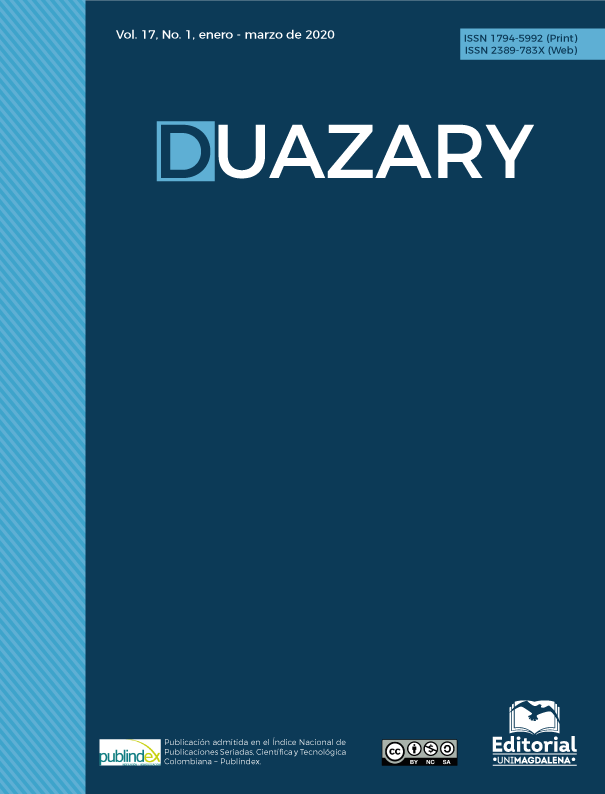Interaction between the perceptual and motor system in patients with central and peripheral lesions: strategies for neurorehabilitation
Main Article Content
Abstract
Traditional approaches to understanding visual perception assume that the main objective of the visual system is to build a detailed representation of the outside world based on the retina that, despite the sophistication of processing, has computational limits to handle the amount of incident information and presence of noise (1).
Downloads
Download data is not yet available.
Article Details
How to Cite
Rodrigues-de França, F. ., Rodríguez-de Ávila, U. E. ., & Pereira-Júnior, A. . (2020). Interaction between the perceptual and motor system in patients with central and peripheral lesions: strategies for neurorehabilitation. Duazary, 17(1), 3–4. https://doi.org/10.21676/2389783X.3215
Section
Editorial
References
1. Marr D. Vision: A Computational Investigation into the Human Representation and Processing of Visual Information. San Francisco, CA: W. H. Freeman. 1992.
2. Gibson JJ. The Ecological Approach to Visual Perception. Boston, MA: Houghton Mifflin. 1979; 11: 227-235. http://dx.doi.org/10.2307/429816
3. Viviani P, Baud‐Bovy G, Redolfi M. Perceiving and tracking kinesthetic stimuli: further evidence of motor–perceptual interactions. J Exp Psychol Hum Percept Perform. 1997; 23(4): 1232–1252. http://dx.doi.org/10.1037/0096-1523.23.4.1232
4. Pozzo T, Papaxanthis C, Petit JL, Schweighofer N, Stucchi N. Kinematic features of movement tunes perception and action coupling. Behavioural Brain Research. 2006; 169(1): 75-82. http://dx.doi.org/10.1016/j.bbr.2005.12.005
5. Rizzolatti G, Fogassi L, Gallese V. . Neurophysiological mechanisms underlying the understanding and imitation of action. Nat Rev Neurosci. 2001; 2(9): 661–70. http://dx.doi.org/10.1038/35090060
6. Saunier G. Martins EF, Dias EC, de Oliveira JM, Pozzo T, Vargas CD. Electrophysiological correlates of biological motion permanence in humans. Behavioural Brain Research. 2013; 236(1): 166-174. http://dx.doi.org/10.1016/j.bbr.2012.08.038
7. Serino A, De Filippo C, Casavecchia C, Coccia M, Shiffrar M, Làdavas E. Lesions to the Motor System Affect Action Perception. Journal of Cognitive Neuroscience. 2009; 22(3): 413-426. http://dx.doi.org/10.1162/jocn.2009.21206.
8. Reed ES. James J Gibson and the Psychology of Perception. New Haven and London: Yale University Press. 1988.
9. Murphy TH, Corbett D. Plasticity during stroke recovery: from synapse to behavior. Nature Reviews Neuroscience. 2009; 10(12): 861-872. http://dx.doi.org/10.1038/nrn2735
2. Gibson JJ. The Ecological Approach to Visual Perception. Boston, MA: Houghton Mifflin. 1979; 11: 227-235. http://dx.doi.org/10.2307/429816
3. Viviani P, Baud‐Bovy G, Redolfi M. Perceiving and tracking kinesthetic stimuli: further evidence of motor–perceptual interactions. J Exp Psychol Hum Percept Perform. 1997; 23(4): 1232–1252. http://dx.doi.org/10.1037/0096-1523.23.4.1232
4. Pozzo T, Papaxanthis C, Petit JL, Schweighofer N, Stucchi N. Kinematic features of movement tunes perception and action coupling. Behavioural Brain Research. 2006; 169(1): 75-82. http://dx.doi.org/10.1016/j.bbr.2005.12.005
5. Rizzolatti G, Fogassi L, Gallese V. . Neurophysiological mechanisms underlying the understanding and imitation of action. Nat Rev Neurosci. 2001; 2(9): 661–70. http://dx.doi.org/10.1038/35090060
6. Saunier G. Martins EF, Dias EC, de Oliveira JM, Pozzo T, Vargas CD. Electrophysiological correlates of biological motion permanence in humans. Behavioural Brain Research. 2013; 236(1): 166-174. http://dx.doi.org/10.1016/j.bbr.2012.08.038
7. Serino A, De Filippo C, Casavecchia C, Coccia M, Shiffrar M, Làdavas E. Lesions to the Motor System Affect Action Perception. Journal of Cognitive Neuroscience. 2009; 22(3): 413-426. http://dx.doi.org/10.1162/jocn.2009.21206.
8. Reed ES. James J Gibson and the Psychology of Perception. New Haven and London: Yale University Press. 1988.
9. Murphy TH, Corbett D. Plasticity during stroke recovery: from synapse to behavior. Nature Reviews Neuroscience. 2009; 10(12): 861-872. http://dx.doi.org/10.1038/nrn2735

